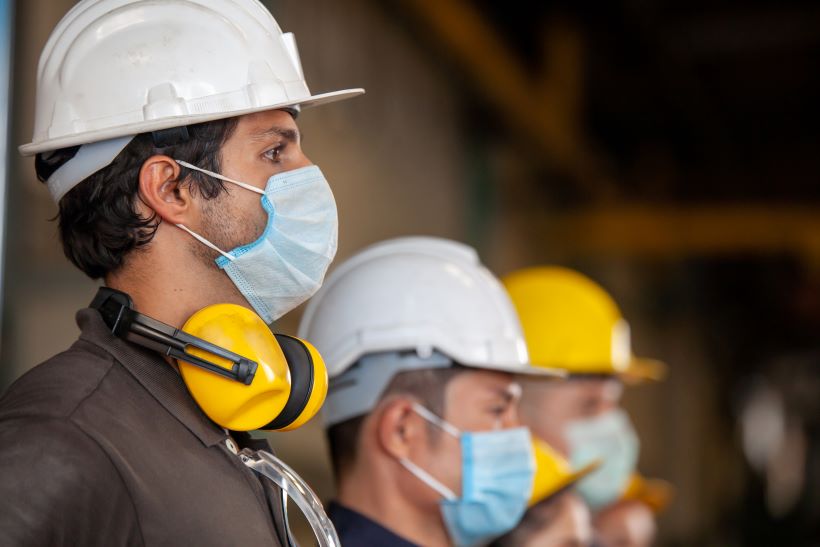Manufacturing plants and industrial sites are opening up again after COVID-19 lockdowns, but the people returning to work will notice many changes in their safety protocols.
Here are five safety guidelines recommended by the Occupational Safety and Health Administration (OSHA) and other organizations and experts:
1. Enforcing social distancing when possible
People often think of social distancing as methods intended to keep at least 6 feet between themselves and others. Some facilities have graphics on the floor to show occupants where to stand, for example. Other options include staggering shifts and limiting the number of people simultaneously allowed in communal spaces, like cafeterias or break rooms.
Employees at an automotive plant in the United Kingdom recently made the first Range Rover built while adhering to social distancing practices. Plant managers also implemented other measures to support worker safety, including offering every employee a reusable face visor. Having warehouse safety procedures to protect people when social distancing becomes difficult is a crucial part of an all-encompassing return-to-work plan.
2. Discouraging the sharing of equipment and supplies
One of the OSHA updates released about COVID-19 practices advises against equipment sharing. Many people naturally want to help their colleagues, so letting others use their supplies seems natural. However, researchers identified the risk of the coronavirus spreading through surfaces. The U.S. Centers for Disease Control and Prevention (CDC) offers disinfection tips for facilities that managers can follow.
One of them recommends using solutions containing at least 70% alcohol for maximum effectiveness. It's also important to consider items that people may share without others asking to borrow them. For example, a job site process where everyone signs a sheet upon arrival needs revisiting because of the number of people touching and using the same pen.
3. Increasing the number of hand-washing stations
The World Health Organization (WHO) issued guidance about the installation of hand-washing stations in highly trafficked areas. It suggests putting them at the entrances of every public and private commercial building, for example. Facility authorities should also make hand-washing an obligatory action before someone crosses a threshold to go into a building, WHO officials said.
Job site rules determined before the pandemic required companies to provide one washing station per 20 employees, but employers may wish to install more. When workers see washing stations readily available, it's easier for them to get in the habit of cleansing their hands before eating. They can also decontaminate personal protective equipment (PPE) that may have touched harmful materials.
4. Implementing temperature checks and well-being assessments
Many warehouse safety procedures involve ensuring employees are fit for work. For example, they may have their temperature checked when entering a site or have to fill out a questionnaire at home that confirms they have not experienced any of the most common COVID-19 symptoms within the last 24 hours.
Companies recognized a need in the market and rushed to develop technologies that help employers screen their workers for symptoms. Despite the rapid adoption of these technological solutions, privacy concerns remain. Some analysts say that these options may not be as effective as advertised for identifying potentially ill workers. Another issue is that the COVID-19 health apps now on the market and purchased by workplaces may not adequately protect privacy.
Nevertheless, businesses are frequently adopting these measures. Some low-tech approaches may prove useful, too. For example, OSHA updates recommend companies to stay abreast of public health recommendations about the coronavirus and give workers access to those tips.
Companies can also plan for sending workers home if they mention feeling sick. If employees see that employers will accommodate them needing to leave early, they'll be less likely to keep quiet about suspected illnesses.
5. Restricting workplace visits
Preparing a workplace to operate safely in the COVID-19 era means thinking differently about site visitors. Perhaps a former process required a person to confirm their arrival time at least 24 hours in advance, plus sign in and out of a site visitor log.
Many industrial sites hosted tours or open days to attract potential clients or get high school students interested in manufacturing careers. Those activities will likely become less commonplace in the new normal where the coronavirus remains a threat. Companies can consider alternatives such as virtual product demonstrations or livestreamed glimpses at factory premises.
In cases where facilities must admit visitors, they should consider having precautionary procedures in place. Those might include giving people disposable masks and having them follow the same sanitation procedures that employees do when entering new sections of a factory or worksite.
Make support available in these changed times
Besides informing workers about warehouse safety procedures such as those above, workplace representatives should emphasize how they are there to respond to any feedback and uncertainty employees may have. For example, people may feel nervous about returning to work, and some may not know how to use masks and other protective equipment properly.
Businesses should create specific communication methods for people to use if they have questions about the new rules or want to suggest changes to safety procedures. When employers show they take worker input into account, it becomes easier to get the workforce on board with what's different now versus before the pandemic.


